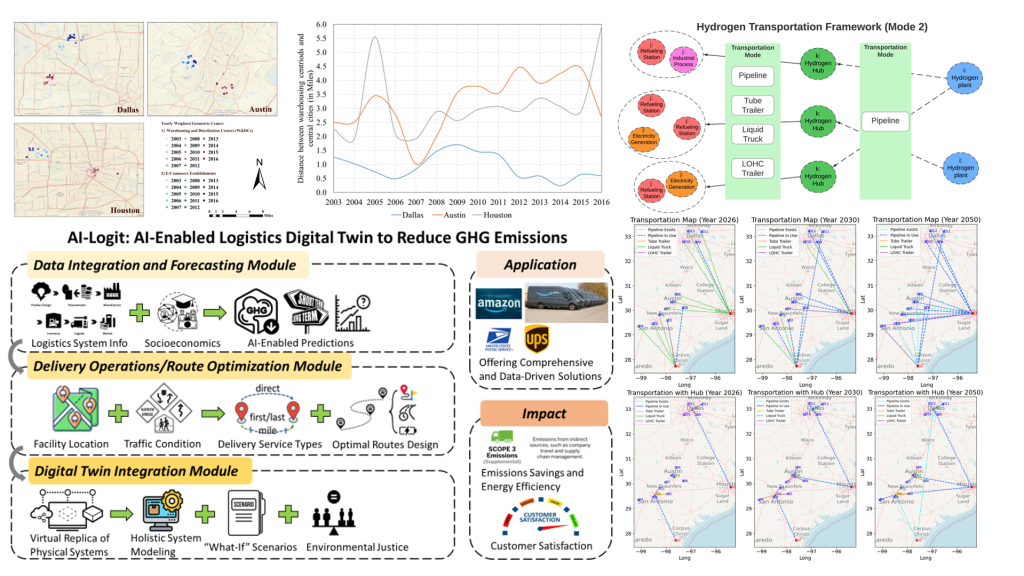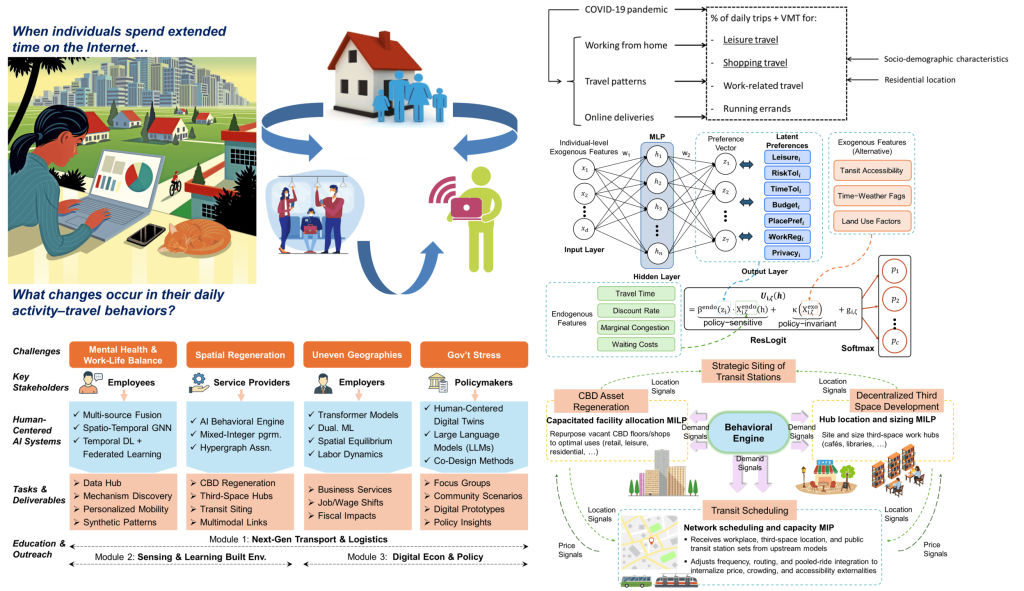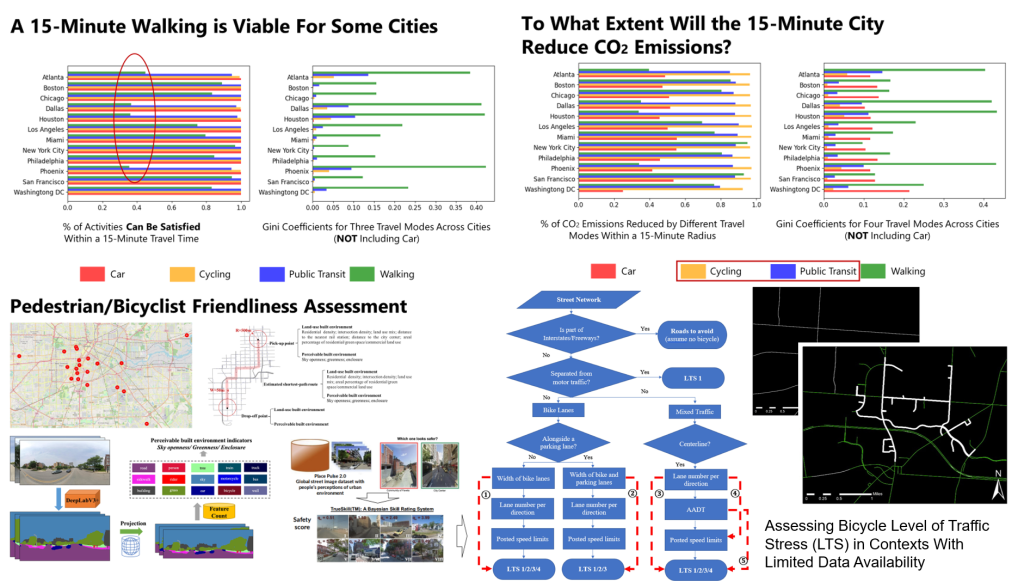Research

Progression 1: AI-Enabled Logistics Digital Twin for Sustainable Freight and Hydrogen Transportation 
Dr. Wang’s group is exploring the use of digital twin and GeoAI technologies to reduce greenhouse gas (GHG) emissions and improve supply chain performance. The proposed AI-Logit framework brings data-driven forecasting, delivery operations optimization, and integrated modeling to support sustainable logistics decision-making.
The research is structured around three core modules:
- Data Fusion and Forecasting Module: combining logistics system information, socioeconomic factors, and AI-enabled predictions to anticipate demand and environmental impacts.
- Delivery Operations and Route Optimization Module: selecting delivery service types, and designing efficient routes under varying traffic and operating conditions.
- Digital Twin Integration Module: creating virtual replicas of physical systems to test “what-if” scenarios, understand system-wide interactions, and evaluate holistic impacts to ensure that the solutions generate fair and shared benefits for all.
The team applies these tools to real-world logistics challenges, producing practical and data-driven insights. Recent case studies include analyzing warehouse–e-commerce co-location patterns across Texas metropolitan areas and designing a multi-period hydrogen transportation model for 2026–2050 to show how cleaner fuels and new infrastructure can reduce emissions.
The expected benefits include major energy savings, lower emissions, and better customer experiences, highlighting how AI and digital twins can drive a more sustainable future for freight and logistics.
Progression 2: A Multi-dimensional Assessment to Enhance Transportation Cybersecurity 
Dr. Wang’s group is developing predictive models that combine data from crowdsourced mobility platforms (e.g., StreetLight, Waze, INRIX) with satellite and aerial remote sensing sources to simulate synthetic cyberattack and hacking scenarios. This work aims to strengthen the resilience of transportation systems against the dual challenges of cyberattacks and extreme weather disruptions. These models help systematically probe system vulnerabilities, showing how failures can spread across interconnected transportation networks. The resulting insights offer high-resolution, real-world perspectives on emerging threats to both physical and digital infrastructure.
Complementing this effort, explainable AI methods are used to study visitor flows, industry clusters, and the spatial dynamics of transportation cybersecurity–related activities. From this view, the transportation cybersecurity industry is conceptualized as an ecosystem, comprising three dimensions infrastructure, social capital, and institutions. The research results can reveal how regional assets, socioeconomic conditions, and institutional strengths come together to influence the industry’s development and resilience.
Additional work involves leading a nationwide study of cybersecurity risk responses among public transit agencies. This study identifies patterns of preparedness, operational protocols, and policy gaps across agencies of varying sizes and resource levels. The findings support strategies for strengthening cyber risk management, improving recovery planning, and informing future federal assistance.
Collectively, these research efforts advance an integrated understanding of how cyber-physical risks emerge, spread, and vary across regions, ultimately supporting the development of more resilient, secure, and adaptive mobility systems.
Progression 3: Social, Behavioral, and Economic Impacts of Remote Work and Mobility Futures

Research in this area examines how digitalization and remote work are reshaping daily activity–travel behaviors and transforming urban systems. The work explores how increased time spent online, through telework, online shopping, and digital leisure, affects mobility patterns, transit demand, and spatial development.
Four interconnected challenges guide this research agenda: mental health and work–life balance, spatial regeneration of urban cores, uneven economic geographies, and governmental stress in adapting policy and infrastructure. To address these issues, the team develops human-centered AI systems, including spatio-temporal neural networks, behavioral digital twins, and optimization-based scheduling and siting models. By combining insights from transportation planning, behavioral economics, and public policy, this research produces solutions such as synthetic mobility patterns, decentralized hub designs, CBD regeneration strategies, and labor market analyses. These outputs aim to support employees, service providers, employers, and policymakers as they navigate the changing landscape of work and mobility.
Through education and outreach, the group translates these insights into classrooms and communities, offering modules on Next-Generation Transport & Logistics, Sensing & Learning the Built Environment, and Digital Economy & Policy. These efforts help prepare future professionals to thrive amid rapid societal and technological change.
Progression 4: 15-Minute City and Active Travel Research

Dr. Wang’s group investigates the transformative potential of the 15-minute city framework to advance accessibility, sustainability, and benefits for all in urban environments. Comparative analyses across major U.S. metropolitan areas evaluate how walking, cycling, and public transit can jointly meet residents’ daily activity needs within short travel distances.
The group evaluates the feasibility of building walkable and bikeable 15-minute cities by upgrading infrastructure across urban, suburban, and even rural contexts. Persistent disparities in accessibility across regions underscore the need for targeted interventions. The research also assesses the potential of shifting toward active and shared modes within a 15-minute travel shed to reduce carbon emissions; results indicate that walking, cycling, and transit can achieve meaningful reductions, though the effectiveness varies by city and mode.
To capture on-the-ground realities, the work incorporates pedestrian and bicyclist friendliness assessments that combines field audits, safety perception mapping, and infrastructure evaluations. Visual documentation highlights street features, crosswalk designs, and protective buffers that shape everyday walkability and bikeability. Additionally, a scalable framework has been introduced for estimating Bicycle Level of Traffic Stress (LTS) in data-insufficient contexts, leveraging simplified street network representations and algorithmic classification to evaluate cycling safety and comfort.